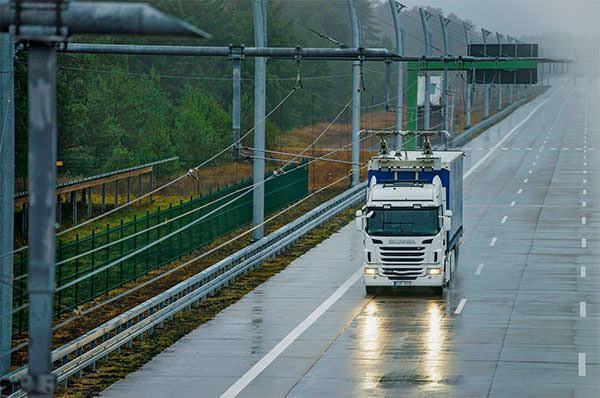For this month is expected to start the first field tests of this particular implementation, which was built along 2 km on a highway near the city of Gävle. The concept is simple and combines the installation of air electrified lines, entirely similar to those of the trains, and of the pantographs on the truck.
Traveling continuously, without ever having to stop to refuel: this is one of the future scenarios that the development of electric cars will bring. When applied to cars maybe can have a limited impact, except in combination with autonomous driving, it is in the transport sector that this scenario could open new paradigms.
 We talked a few months ago the British plan to start a pilot project for the construction of a wireless charging system for electric vehicles that do not require the stop of the vehicle, via the magnetic coupling by resonance between coils embedded in the asphalt and those located the car down, thus creating real road lanes where electric vehicles can recharge the batteries while they are traveling.
We talked a few months ago the British plan to start a pilot project for the construction of a wireless charging system for electric vehicles that do not require the stop of the vehicle, via the magnetic coupling by resonance between coils embedded in the asphalt and those located the car down, thus creating real road lanes where electric vehicles can recharge the batteries while they are traveling.
The project seems very futuristic, while other types are much closer to their final realization. One of them is that of the electrified lanes for hybrid trucks on Swedish highways. For this month is expected to start the first field tests of this particular implementation, which was built along 2km on a highway near the city of Gävle.
The concept is simple and combines the installation of air electrified lines, entirely similar to those of the trains, and of the pantographs on the truck, also in this case in a way altogether similar to what happens for the transport rail.
 The trucks equipped with hybrid drive when they are in the right lane automatically raise the pantograph, using the current to advance the medium by electric motor. In case of deviations or overtaking the vehicle can exit freely from the electrified lane, passing to the heat engine, the hybrid drive or the electric battery, depending on the case.
The trucks equipped with hybrid drive when they are in the right lane automatically raise the pantograph, using the current to advance the medium by electric motor. In case of deviations or overtaking the vehicle can exit freely from the electrified lane, passing to the heat engine, the hybrid drive or the electric battery, depending on the case.
Returning then to the middle lane starts to travel in purely electric mode, powered by the energy of the electrical network. The system is the protagonist for trial the brand of heavy vehicles of the Volkswagen Group, Scania, together with Siemens.
The system involves the installation of overhead lines, then with greater simplicity of construction of embedded systems in the asphalt, and it seems to be a good way to also help the world of heavy transports to exploit the potential of the electric drive, without requiring purely dedicated lanes: those electrified may be used by vehicles normally devoid of a pantograph. Sweden has pushed hard for this project as it could facilitate the achievement of its objectives, which provide independence from fossil fuels by 2030 and fleet of vehicles throughout the country by 2050.

